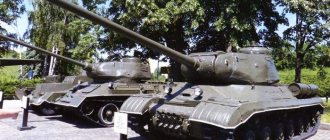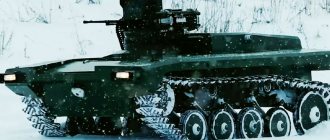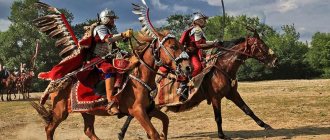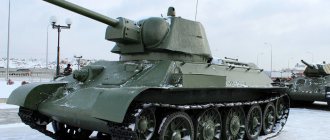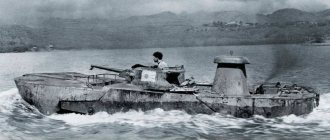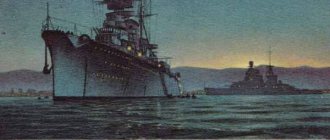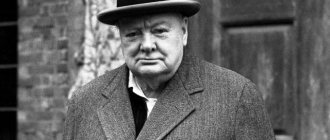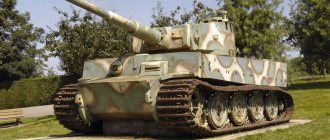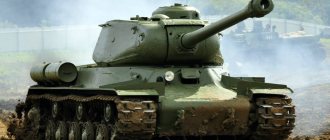Good day, dear tankers! Our favorite game World of Tanks is turning 8 years old, which means it's time for gifts and surprises. It is noteworthy, but gifts will be given out by Wargaming, and we will talk about one present now. In honor of the significant date, all players are entitled to a gift LT tank of the 2nd level, Poland. This is the TKS z nkm 20 m - a wedge on which the Polish tanker Roman Orlik managed to destroy 7 German tanks. The vehicle is premium, and to get it into the hangar you only need to fight 1 battle using any vehicle.
The distribution of the tank begins on August 10th and ends on the morning of August 13th. So, let’s get to know this machine in more detail to figure out how useful this present will be.
TKS z nkm 20 m: performance characteristics
Let's start our TKS 20 guide with the fact that as a gift for the 8th anniversary of WoT, the Polish tank does not look very good, however, like many other gifts that WG gives out for free. Therefore, experienced players who prefer to increase efficiency in the sandbox are unlikely to be interested in this machine.
For beginners, the Polish wedge heel will help you earn some silver and experience. Note that the word "a little" is key: this baby's farmer is pretty mediocre. In any case, the tank is absolutely free, so if necessary, you can sell it, gaining a little game currency and freeing up a slot in the hangar. You can also keep the car for collection: it does not require food or service.
However, let’s stop thinking and start our review of the TKS 20. So, the wedge, unlike a full-fledged tank, is a light and maneuverable reconnaissance vehicle, which completely lacks armor and heavy weapons. The technique is not suitable for pushing directions and direct firefights with the enemy. Our gift “Pole” fully fits into this concept.
So, we are offered a safety margin of 160 units. This is not a standard indicator, but quite decent by the standards of tier 2 light tanks. A similar opinion can be expressed about the viewing radius, which is 290 meters: it looks good, but many classmates see further. The tank accelerates to 45 km/h.
20 mm machine gun TKS z nkm 20 m
Our weapons are quite ambiguous. On the one hand, you cannot expect high firepower from the 20-mm TKS z nkm 20 m machine gun; on the other hand, this is a premium equipment, the profitability of which also depends on alpha and DPM.
For its level, the “Pole” has relatively good penetration: 43 mm allows you to comfortably deal with classmates and some high-level equipment. At the same time, with each successful hit we can reduce the enemy’s health reserve by 11 units.
The cassette holds 10 shells, and the tank takes 6.7 seconds to reload. Based on these stats, the average DPM is 780 damage. The gun is brought down in 2 seconds, which, taking into account the rate of fire, is far from an ideal indicator.
The spread is 0.4 per 100, however, this parameter can not be particularly considered: machine guns are melee weapons, unsuitable for remote firefights. The stabilization of the installed weapons is unexpectedly good, which significantly increases the efficiency of firing while moving.
The armor of the TKS tank can be completely ignored. The maximum thickness of the armor plates is observed in the frontal projection of the turret - as much as 10 mm; the situation is slightly saved by the gun mask, increasing this modest value by 2 times.
The sides and stern are protected by 8 mm armor plates. In general, the tank breaks through quite comfortably, however, like most light tanks of the 2nd level. It is not yet known how well the newcomer will be set on fire, but given the level of its protection, we can assume that the probability of the engine catching fire and the ammo rack crit will be quite high.
Characteristics of the TK-3 TKS wedge
A country:PolandType:Wedge heelDate of issue:1929Length:2.58 mWidth:1.78 mHeight:1.3 mArmor, forehead:3-8 mmArmor, side:3-8 mmArmor, tower:3-8 mmCrew:2 peopleEngine:gasoline Ford-A, 40 hp.Travel range:200 kmMaximum speed:45 km/hWeight:2.4 tonsWeapons:1x 7.92 mm machine gun (1800 rounds)
Characteristics are given for TK-3
Equipment on TKS 20
Let us immediately clarify that it is better to choose modules at your own discretion, guided by your own game tactics. However, given some of the technical features of this machine, we recommend that you first pay attention to the following modules:
- Enlightenment - for LT it is important to play from the view, so this indicator needs to be improved by any means.
- Stabilizer – weapon accuracy clearly needs optimization;
- Ventilation is a minor but useful bonus to all characteristics.
A gun rammer is not installed on such vehicles, but you can try replacing the last module with a camouflage net or anti-fragmentation lining. The first option is suitable only for those players who prefer to stick to ambush tactics or work in a team as a passive light.
An architecture student and his “cockroaches”
On September 9, 1939, one of the first major battles of World War II began - the Battle of Bzura. The Polish armies "Poznan" and "Pomerania", retreating east from the Poznan ledge, found themselves in the rear of the German Army Group "South" rushing towards Warsaw. Moving on night marches, the Poles secretly reached the valley of the Bzura River and delivered a powerful blow to the left flank of the 8th Army of the Wehrmacht. When advancing to the southeast, they liberated several cities and forced the German command to reconsider plans for operations in central Poland, transferring additional tank and aviation units to Bzura. The situation for the Germans in this area was so critical that, for example, on September 17, the Luftwaffe practically canceled all flights except those related to the Bzura area. However, the Poznan and Pomorie armies could not reverse the general course of hostilities - on September 12, the Germans approached Lvov, and on the 14th they completed the encirclement of Warsaw.
Among other military units, the Poznań Army included the Wielkopolska Cavalry Brigade, which included 71 armored battalions (71 Dywizjon Pancerny). Of the three companies of this unit, formed immediately before the war (August 24–27), only one was equipped with vehicles that, with a certain degree of convention, can be called tanks. These were thirteen TKS (and possibly TK-3) machine-gun wedges, four of which the Poles managed to rearm with 20 mm wz automatic cannons. 38 model A (according to the Polish classification, this weapon was classified as a “super-heavy machine gun”). One of these tankettes with “heavy” weapons was commanded by a student of the Warsaw University of Technology, platoon commander Sergeant Roman Edmund Orlik, who was drafted into the army on August 26. The second member of the two-person crew was driver Bronislaw Zakrzewski.
Roman Edmund Orlik (foreground) with Bronislaw Zakrzewski at his combat vehicle
During the Battle of Bzura, the Wielkopolska Cavalry Brigade fought heavy battles against the 4th Panzer Division of the 16th Motorized Corps of the 10th Wehrmacht Army. On September 14, the brigade attacked the Germans in the Brochow area. In this battle, Orlik destroyed 3 tanks from the 36th Tank Regiment; most likely, these were PzKpfv I and PzKpfv II vehicles, which formed the basis of the tank fleet of the German 4th division.
On September 18, the Wielkopolska Cavalry Brigade, as part of the Operational Cavalry Group, formed to clear the path to Warsaw for the rest of the Polish units of the Poznan Army surrounded by the Germans, fought in the Kampinoska Forest area west of the capital. A platoon (in Polish sources – half-platoon, półpluton) of Orlik, consisting of his vehicle and two more tankettes with machine gun weapons, was sent on reconnaissance. Hearing the noise of tank engines ahead, the sergeant sent vehicles with machine guns into cover, and he himself lay in ambush.
Scheme of a tank battle on September 18, 1939, drawn by Roman Orlik himself after the war
A column of three tanks and several vehicles of the 1st Wehrmacht Light Division was moving along the road in front of the Polish tankette. Suddenly opening fire, the Polish tankman shot into the side and destroyed the lead German tank right on the road, forcing the remaining vehicles to move into the forest to detour. Changing positions, Orlik destroyed the remaining two German tanks, put the rest of the German column to flight and left the battle with his platoon without losses.
Some sources indicate that all three tanks destroyed by Orlik on September 18 were Czech PzKpfw 35(t), which formed the basis of the tank fleet of the 1st Light Division. However, it is highly likely that one of these tanks was a PzKpfw IV. The 1st Light Division had a small number of them in service, and during the period from September 1 to 25, the division lost up to 9 tanks of this type. In the battle, among others, the commander of a tank platoon, Lieutenant Victor IV Albrecht, Prince of Ratiborsky, was seriously wounded and died - a number of sources indicate that it was he who commanded the crew of the PzKpfv IV, and even provides a photograph of his destroyed combat vehicle.
Presumably, the photo shows the PzKpfv IV of Prince Victor Albrecht, destroyed by Roman Orlik in battle on September 18
On September 19, Orlik took part in the battle for Sierakow, where several dozen tanks of the German 11th Tank Regiment and the 65th Tank Battalion attacked the 7th Mounted Rifle Regiment and the 9th Lancer Regiment of the Poles. In this battle, the battery of the 7th Horse Artillery Division and Polish tank crews destroyed and knocked out more than 20 German tanks, of which Orlik’s tankette accounted for 7 vehicles. Orlik captured two German tank crews. Then Orlik managed to bring his tankette to Warsaw, took part in its defense, and after the fall of the city he joined the Polish resistance forces. He managed to survive the war, after which he worked in his specialty - as an architect.
Taking into account the vehicle in which Orlik fought, his achievements (13 knocked out and destroyed tanks in less than a week of fighting) look very worthy. The small, lightly armored and weakly armed TKS wedge, at first and second glance, was not very suitable for the role of a formidable tank destroyer. Nevertheless, as practice has shown, in the right hands it could be a formidable weapon - and, given that Orlik became a tank driver just a few days before the start of the war, it apparently was not difficult to master.
So what are these armored vehicles, about which, as the Polish military historian Janusz Magnuski writes, a German tank officer captured by the Poles responded with these words:
“...it’s very difficult to hit such a small cockroach with a cannon”?
Perks for the crew on TKS 20
Under the cardboard armor of the wedge, only the commander and driver are located, which both simplifies and complicates the learning of the crew's skills. We recommend starting from the basics and exploring the repair, firefighting and camouflage perks for tankers. Then we open “Combat Brotherhood”, then specialized skills.
Don’t forget to load up your strap, first aid kit and fire extinguisher before each fight. Considering that the Polish Prem does not have reliable protection, every successful enemy shot will break the internal modules or negatively affect the health of the small crew.
TK-3 TKS wedge design
The body was a frame to which 3-8 mm folded armor plates were attached with rivets. The design of the TK-3 wedge retained many common features with the original English version. The chassis was extremely simple and included on each side two bogies with two rubberized road wheels each, four support rollers, a front drive wheel, and a rear wheel guide. The small-link caterpillar chain consisted of steel tracks 140 mm wide and 127 mm long. The suspension of the bogies with road wheels included leaf springs.
The interior was a single compartment. The crew consisted of two people. The driver sat on the left side. The tankette commander, who also served as a rifleman, was on the right side. The armament consisted of a Hotchkiss wz.25 machine gun of 7.92 mm caliber, the ammunition load of which was 1800 rounds. This machine gun could also fire at air targets.
TKS differs in appearance from TK-3 with a more “pleasant” body shape
The engine and gearbox were located in the middle; on the right side there was a pin with a fork for a spare anti-aircraft machine gun, from which the commander fired after going outside.
The wedge had a mechanical transmission (in the front of the hull), and the engine, fuel tank and radiator were in the stern. The TK-3 wedges were equipped with a 4-cylinder Ford-A gasoline engine with a power of 40 hp, which was produced in Poland under license.
How to play on TKS 20
In general, you can stick to typical LT tactics, especially if random throws the Pole into high-level battles. Here we ride around the center of the map (if the landscape allows), highlight the enemy and receive bonuses for the damage caused by our teammates.
Second option: we occupy dense bushes in a direction promising for enemy attack and stand with passive light. In both cases, the machine has a significant drawback: the turret does not rotate completely. Taking into account this feature, you should not allow the enemy to carousel you in close combat.
Another option for fighting on this wedge is possible: to become a fire support vehicle. In this case, you can take a position on the 2nd line of attack and help the allied forces deal with the enemy.
At the same time, we should not forget that the TKS 20 remains a light and fairly maneuverable tank, capable of quickly shifting to the other flank, attacking the enemy from an unexpected angle, discharging a machine-gun belt into the vulnerable sides and stern.
Modifications of the TK-3 TKS wedge
- TK-1 - prototype
- TK-2 - prototype
- TK (TK-3) - serial version, ~280 units produced since 1931.
- TKF - TK-3 wedge with 46 hp engine. ~18 units produced.
- TKS (1933) - modernized wedge, ~260 produced.
- TKS with 20 mm gun, approximately ~24 TKS were equipped with a 20 mm gun in 1939.
- TKD - light self-propelled artillery unit with a 47 mm gun, 4 copies were produced.
- C2P - light artillery tractor, ~200 produced.
- TKW - light reconnaissance tank with a turret, 1 copy produced
- TKS-D - light self-propelled gun with a 37-mm Bofors anti-tank gun, 2 copies were produced.
The same TKS wedge with a 20 mm gun
Brief summary of TKS 20
Let's summarize the above by making a small analysis of the strengths and weaknesses of the machine. Let's start with the positive characteristics.
Pros:
- Comfortable armor penetration;
- Relatively good review;
- Compact silhouette;
- High rate of fire.
Minuses:
- Weak acceleration dynamics;
- Limited horizontal guidance angles;
- Not the best at the DPM level;
- Complete lack of reservation.
In general terms, the tank turns out to be slightly below average, so it won’t be able to please the players with anything fundamentally new or interesting. However, let’s not forget that we are talking about a premium car, which can help beginners who are just mastering the game to rise financially, or, in extreme cases, get a free slot in the hangar.
Let us remind you that the car is given free of charge to all players, without exception, who have played 1 battle on any vehicle after August 10th. They don’t look into the trunk of a gifted “Pole”, especially since it is impossible to refuse the gift no matter how much you want.
Combat use of the TK-3 TKS wedge
By the beginning of the German invasion in September 1939, TK-Z and TKS were in separate companies of infantry divisions and separate squadrons of cavalry brigades as reconnaissance units. There were more than five hundred of them in total.
Despite their outdated design and weak weapons, the tankettes did everything in their power to hold off the enemy. Of course, these small armored vehicles could not resist German tanks, but there is a well-documented fact: tanker Roman Edmund Orlik on a TKS wedge with a 20-mm gun (unfortunately, only one of four) managed to knock out 13 enemy tanks in the battles for Poland.
TK-3 wedge heel against the background of the German Pz III tank
• Directory of armored vehicles • Armored vehicles of the same period •
Source: compilation based on publicly available information on the Internet
